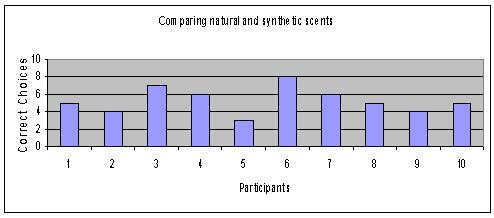| Complexity level: | 5 |
| Project cost ($): | 100 |
| Time required: | 1 hour to prepare, 1 hour for observation |
| Material availability: | Easily found |
| Safety concerns: | Basic safety requirements |
Hypothesis
Most of the participants will not be able to differentiate between natural and synthetic scents.
Overview
Natural and synthetic scents
Our sense of smell is also known as olfaction. Olfaction refers to the ability of organisms to detect chemicals in the air that may be pleasant, e.g. odors from flowers, fruits or food, or unpleasant, e.g. odors from the smell of a decomposing organic matter or garbage. Odors enter our nostrils and the sensory cells in the nasal cavity detect them. Signals regarding the odor will then be transmitted to the brain. The brain will then recognize or retain memory of that smell.
People usually use perfumes to hide an odor and to create a more pleasant aroma around them. Perfume is made from oils that are extracted from plants or animals. However, to create these natural scents, large quantities of plants or animal matter are required just to obtain a small amount of oil. This puts a constraint on production capacity and it also increases the cost of the perfume. Obtaining a level of consistency in the scent is also difficult because the scent of the extract differs by the season and location.
Artificial perfumes are synthetic scents that are manufactured by chemical synthesis. They are normally cheaper and their quality and consistency can be more easily controlled. The production of synthetic perfume is also more environmentally friendly because animals such as the musk deers or plants like the sandalwood tree do not have to be harmed or destroyed, in order to extract these scents.
Scientific Terms
Materials
The materials required for this science fair project:
- A bottle each of natural scents – rose, banana, orange, lemon, lavender, apple, cinnamon, jasmine, vanilla and strawberry scents
- A bottle each of synthetic scents – rose, banana, orange, lemon, lavender, apple, cinnamon, jasmine, vanilla and strawberry scents
- 200 pieces of tissues
- 10 participants
- A black marker pen
Procedure
1. For this science fair project, the independent variable is the natural or synthetic scent and the fragrance of the scent - rose, banana, orange, lemon, lavender, apple, cinnamon, jasmine, vanilla and strawberry. The dependent variable is the choice of the natural scent selected by the participant. This is determined by asking the participants to smell the scents and identify the natural scent. The constants (control variables) are the number of fragrances, the amount of scent on each tissue and the size of the tissue paper.
2. The bottles containing natural and synthetic fragrances of rose, banana, orange, lemon, lavender, apple, cinnamon, jasmine, vanilla and strawberry are purchased from a local department store.
3. The 200 pieces of tissues are separated into 10 groups of 20 tissues each. Using the marker pen, the tissues in each group are labeled as “rose”, “banana”, “orange”, “lemon”, “lavender”, “apple”, “cinnamon”, “jasmine”, “vanilla” or “strawberry”. The 20 tissues in each group are further separated into 2 and marked as “A” or “B”. A drop of natural or synthetic fragrance is placed on each tissue according to the marking. For each of the 10 scents, the natural or synthetic scents will be marked “A” or “B” randomly . The choice of “A” or “B” for the natural / synthetic scents will be recorded but not revealed to the participants.
4. Each of the 10 participants are given 20 tissues (10 fragrances of “A” and “B”) and they are asked to select the 10 tissues that they think, contain natural scents. Their selected tissues are collected and the number of correct choices is recorded in the table below. They should not be told how many synthetic/natural scent samples have been given to them.
5. If the participant makes close to 10 correct choices, then they are regarded to have successfully differentiated between the natural and synthetic scents. If 7 or 8 correct choices are made, then they are regarded to be fairly successful in differentiating between natural or synthetic scents. However, if only 6 or less correct choices are made, then the participant(s) are regarded to be unable to differentiate between the natural and synthetic scents.

Results
It is observed that 8 out of 10 participants were able be make no more than 6 correct choices. This means that 80% of the participants were unable to differentiate between natural and synthetic scents.
| Category | Correct choice between 10 natural and synthetic scents | |||||||||
| 1 | 2 | 3 | 4 | 5 | 6 | 7 | 8 | 9 | 10 | |
| Number of Correct Choices made | 5 | 4 | 7 | 6 | 3 | 8 | 6 | 5 | 4 | 5 |
Use the below graph to plot the results of above observation.

Conclusion
The hypothesis that most participants will not be able to differentiate between natural and synthetic scents is proven to be correct.
One of the first lines of perfume to use artificial scents was Channel No. 5 by Coco Chanel. This perfume was created in the 1920s and it is still in the market today. The perfume uses aldehyde and a mixture of several scents. There are many perfumes sold today that uses aldehyde because it adds a “sparkle” to the scent.
Also consider
Try repeating this science fair project, to determine how sensitivity of smell may vary according to the participant’s age?
The experiment can also be done to compare the ability of male versus female participants to effectively differentiate between natural and. synthetic fragrances.
References
Notes on scents – natural vs synthetic fragrance - http://beautyproducts.beautorium.com/2008/10/07/notes-on-scents-natural-vs-synthetic-fragrance/
Synthetic perfume versus natural scents- which is better? - http://ezinearticles.com/?Synthetic-Perfume-Versus-Natural-Scents---Which-Is-Better?&id=599079
Olfaction - http://en.wikipedia.org/wiki/Olfaction

